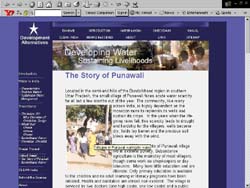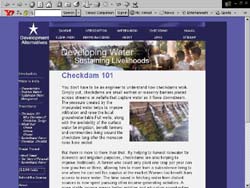|
Developing Water Sustaining Livelihoods
Ambika Sharma ambi@sdalt.ernet.in T he purpose of Sustainable Water Management (SWM) is simply to manage our water resources while taking into account the needs of present and future users. Sustainable Water Management in IndiaThe statistics show an alarming trend for India: rapid population growth,
urbanization and industrialization will lead to a greater demand for an increasingly smaller supply of water resources in the area. How will India avert the looming crisis? The needs of India, and indeed the South Asian region to which it belongs, are unique. Nowhere else in the world does population growth and poverty play such a large role in affecting water resource issues. To address the specific concerns of the region, the World Water Council formed a Regional Water Vision 2025 for South Asia. A product of dialogue and debate between organizations from the region, the Vision 2025 reflects the current position of South Asia on the sustainable development of their water resources: “Poverty in South Asia will be eradicated and living conditions of all people will be uplifted to sustainable levels of comfort, health and well-being through co-ordinated and integrated development and management of water resources in the region.” This vision reflects the importance of providing for basic human needs to ensure that the livelihoods of all can be improved. In the case of South Asia, poverty and reduced access to safe water resources has limited the ability of the poor to improve their situation, which has only served to perpetuate the poverty cycle especially among rural populations and women. The South Asia Regional Water Vision 2025 identified a number of common issues for water management in the region:
These issues affect both the region as a whole and the individual nations in varying degrees. For India, the two most important issues are how to balance the country’s rapid economic growth with the need to ensure equitable distribution to all sectors, in particular the urban and rural drinking water supply. Development Alternatives (DA) has worked extensively over the past twenty years to develop sustainable water management initiatives in both rural and urban India. From helping poor communities build checkdams in the Bundelkhand to teaching schoolchildren how to analyze water quality through the CLEAN-India Program, we strive to improve the livelihood of Indians by promoting access to safe and abundant water resources.
The Development Alternatives Water module online was developed to highlight the various projects in sustainable water management undertaken by our organization. It also describes the current water resource issues being faced in India as well as defines our vision of Sustainable Water management as it applies to the Indian context. A listing of on-line resources has also been added for those who care to delve more in-depth into the issues and learn more about the activities of various organizations working in the field of water. Checkdams in Bundelkhand by Development Alternatives,Jhansi You don’t have to be an engineer to understand how checkdams work. Simply put, checkdams are small earthen or masonry barriers placed across streams or nallahs that capture water as it flows downstream. The pressure created by the impounded water helps to improve infiltration and raise the local groundwater table. Full wells, along with the availability of the surface water for irrigation, benefit farmers and communities living around the checkdam long after the monsoon rains have ended. But there is more to them than that. By helping to harvest rainwater for domestic and irrigation purposes, checkdams are also helping to improve livelihoods. A farmer who could only plant one crop per year can now grow two or three, allowing him to move from a subsistence living to one where he can sell his surplus at the market. Women too benefit from access to more water. The time saved in fetching water from distant sources is now spent pursuing other income-generating activities. A more stable income means better nutrition and education opportunities for the children and an overall improvement in the daily life of the entire family. q
(Adapted from the DA water module by |

